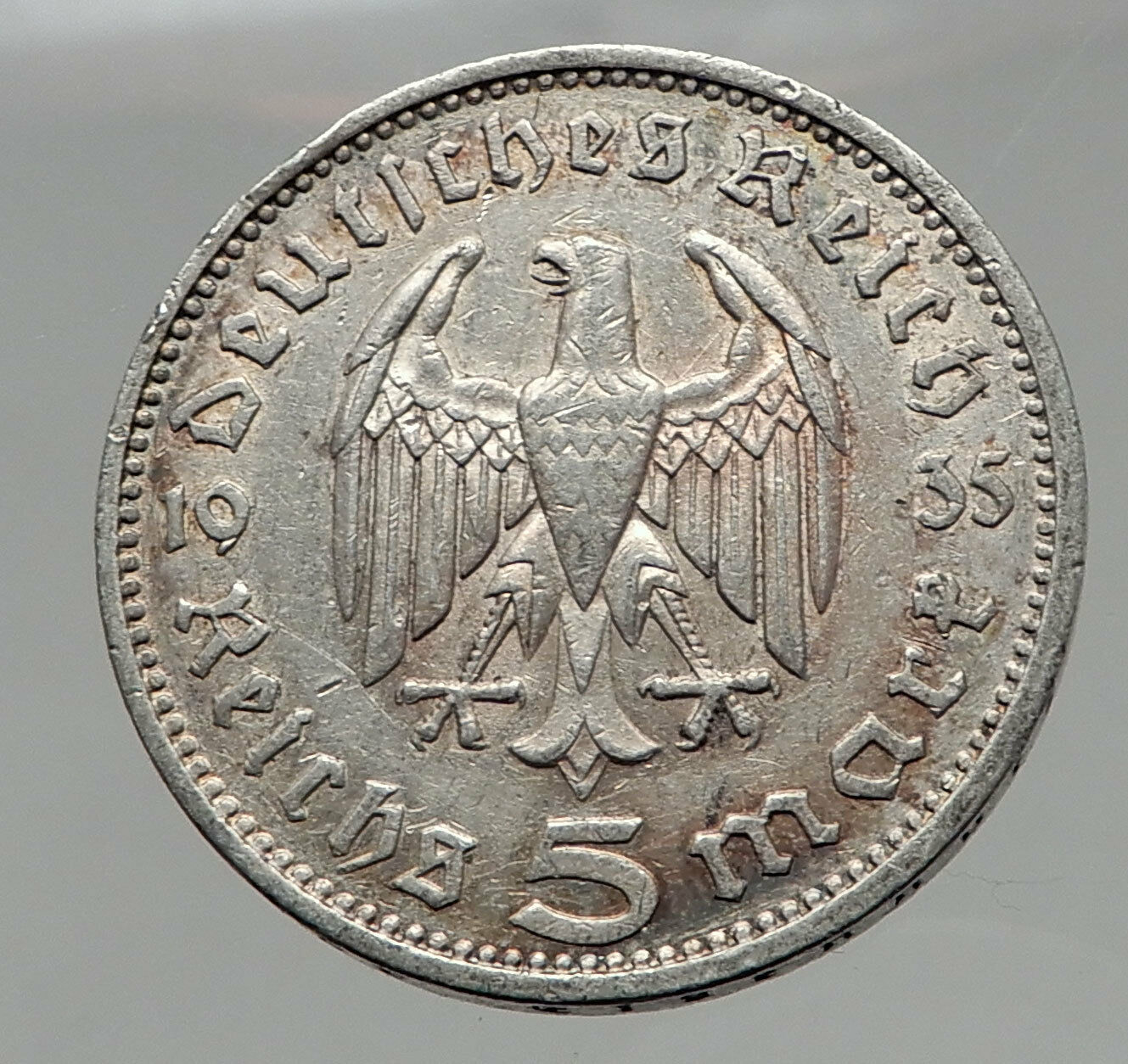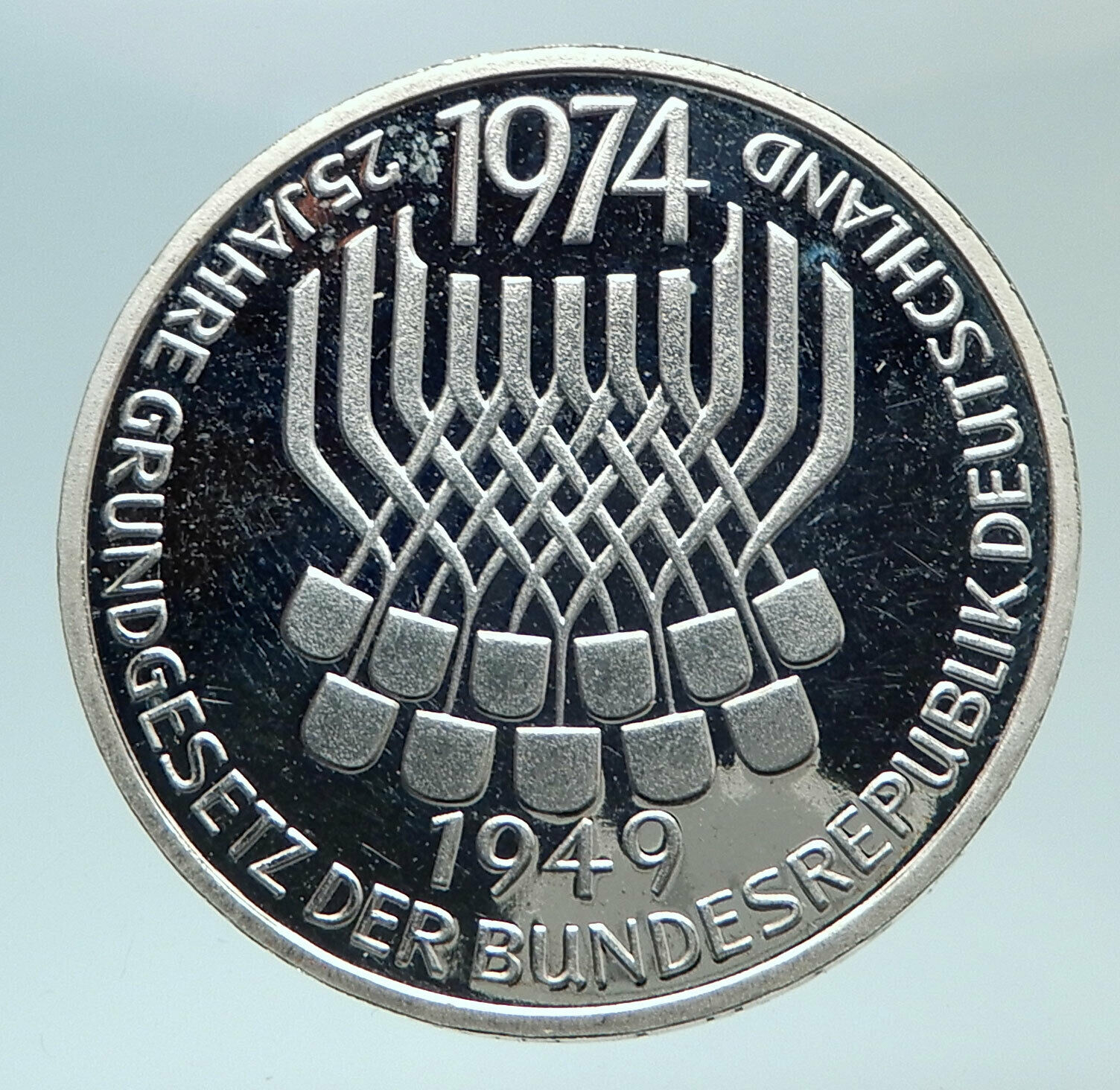|
Germany
150th Anniversary – German Archaeological Institute
1977 J Silver 5 Mark 29mm (11.20 grams) .625 Silver (0.2251 oz. ASW)
Reference: KM# 145 | Engraver: Karl Föll
BUNDESREPUBLIK DEUTSCHLAND DEUTSCHE MARK 19 5 79 J, Eagle above inscription.
150 JAHRE DEUTSCHES ARCHÄOLOGISCHES INSTITUT 1829-1979, Griffin from the seal of the German Archaeological Institute.
Edge Lettering:
MONUMENTIS AC LITTERIS
You are bidding on the exact item pictured, provided with a Certificate of Authenticity and Lifetime Guarantee of Authenticity.
 The German Archaeological Institute (German: Deutsches Archäologisches Institut, DAI) is a research institute in the field of archaeology (and other related fields). The DAI is a “federal agency” under the Federal Foreign Office of Germany. The German Archaeological Institute (German: Deutsches Archäologisches Institut, DAI) is a research institute in the field of archaeology (and other related fields). The DAI is a “federal agency” under the Federal Foreign Office of Germany.
Eduard Gerhard founded the institute. Upon his departure from Rome in 1832, the headquarters of the Instituto di corrispondenza archeologica, as it was then named, was established in Berlin. Its predecessor institute was founded there by Otto Magnus von Stackelberg, Theodor Panofka and August Kestner in 1829.
Hans-Joachim Gehrke was President of the Institute from March 2008 to April 2011, and has been succeeded by Friederike Fless.The DAI currently has offices in cities including Madrid, Rome, Istanbul, Athens, Cairo, Damascus, Baghdad, Tehran and Sana’a.
The DAI’s Romano-Germanic Commission (Römisch-Germanische Kommission) includes the world’s largest library for prehistoric archaeology and is located in Frankfurt. Its commission for the History of Classical Antiquity is in Munich and its Commission for the Archaeology of Non-European Cultures is located in Bonn.
  Germany, officially the Federal Republic of Germany is a federal parliamentary republic in western-central Europe. It includes 16 constituent states and covers an area of 357,021 square kilometres (137,847 sq mi) with a largely temperate seasonal climate. Its capital and largest city is Berlin. With 81 million inhabitants, Germany is the most populous member state in the European Union. After the United States, it is the second most popular migration destination in the world. Germany, officially the Federal Republic of Germany is a federal parliamentary republic in western-central Europe. It includes 16 constituent states and covers an area of 357,021 square kilometres (137,847 sq mi) with a largely temperate seasonal climate. Its capital and largest city is Berlin. With 81 million inhabitants, Germany is the most populous member state in the European Union. After the United States, it is the second most popular migration destination in the world.
Various Germanic tribes have occupied northern Germany since classical antiquity. A region named Germania was documented before 100 CE. During the Migration Period the Germanic tribes expanded southward. Beginning in the 10th century, German territories formed a central part of the Holy Roman Empire. During the 16th century, northern German regions became the centre of the Protestant Reformation.
The rise of Pan-Germanism inside the German Confederation resulted in the unification of most of the German states in 1871 into the Prussian-dominated German Empire. After World War I and the German Revolution of 1918-1919, the Empire was replaced by the parliamentary Weimar Republic. The establishment of the Third Reich in 1933 led to World War II and the Holocaust. After 1945, Germany split into two states, East Germany and West Germany. In 1990, the country was reunified.
 In the 21st century, Germany is a great power and has the world’s fourth-largest economy by nominal GDP, as well as the fifth-largest by PPP. As a global leader in several industrial and technological sectors, it is both the world’s third-largest exporter and importer of goods. Germany is a developed country with a very high standard of living sustained by a skilled and productive society. It upholds a social security and universal health care system, environmental protection and a tuition free university education. In the 21st century, Germany is a great power and has the world’s fourth-largest economy by nominal GDP, as well as the fifth-largest by PPP. As a global leader in several industrial and technological sectors, it is both the world’s third-largest exporter and importer of goods. Germany is a developed country with a very high standard of living sustained by a skilled and productive society. It upholds a social security and universal health care system, environmental protection and a tuition free university education.
Germany was a founding member of the European Union in 1993. It is part of the Schengen Area, and became a co-founder of the Eurozone in 1999. Germany is a member of the United Nations, NATO, the G8, the G20, and the OECD. The national military expenditure is the 9th highest in the world. Known for its rich cultural history, Germany has been continuously the home of influential artists, philosophers, musicians, sportsmen, entrepreneurs, scientists and inventors.
|





 The German Archaeological Institute (German: Deutsches Archäologisches Institut, DAI) is a research institute in the field of archaeology (and other related fields). The DAI is a “federal agency” under the Federal Foreign Office of Germany.
The German Archaeological Institute (German: Deutsches Archäologisches Institut, DAI) is a research institute in the field of archaeology (and other related fields). The DAI is a “federal agency” under the Federal Foreign Office of Germany.
 Germany, officially the Federal Republic of Germany is a federal parliamentary republic in western-central Europe. It includes 16 constituent states and covers an area of 357,021 square kilometres (137,847 sq mi) with a largely temperate seasonal climate. Its capital and largest city is Berlin. With 81 million inhabitants, Germany is the most populous member state in the European Union. After the United States, it is the second most popular migration destination in the world.
Germany, officially the Federal Republic of Germany is a federal parliamentary republic in western-central Europe. It includes 16 constituent states and covers an area of 357,021 square kilometres (137,847 sq mi) with a largely temperate seasonal climate. Its capital and largest city is Berlin. With 81 million inhabitants, Germany is the most populous member state in the European Union. After the United States, it is the second most popular migration destination in the world. In the 21st century, Germany is a great power and has the world’s fourth-largest economy by nominal GDP, as well as the fifth-largest by PPP. As a global leader in several industrial and technological sectors, it is both the world’s third-largest exporter and importer of goods. Germany is a developed country with a very high standard of living sustained by a skilled and productive society. It upholds a social security and universal health care system, environmental protection and a tuition free university education.
In the 21st century, Germany is a great power and has the world’s fourth-largest economy by nominal GDP, as well as the fifth-largest by PPP. As a global leader in several industrial and technological sectors, it is both the world’s third-largest exporter and importer of goods. Germany is a developed country with a very high standard of living sustained by a skilled and productive society. It upholds a social security and universal health care system, environmental protection and a tuition free university education.




